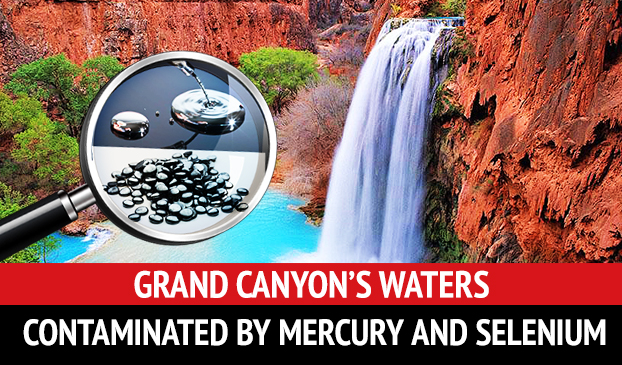
Studies show the Grand Canyon has been contaminated by mercury and selenium from a nearby coal burning power plant and distant river irrigation runoff.
The Grand Canyon has been a world heritage site since 1979. Despite the desire to protect it, pollution has permeated its natural features.
Findings from a recent U.S. Geological Survey study shows alarming levels of mercury and selenium in the Grand Canyon’s ecosystem, creating a risk for fish, other area wildlife and humans.
The Study

Mercury is a dangerous chemical that has been linked to autism, psychotic reactions, hallucinations, suicidal tendencies and delirium.
Via: RSC
Researchers examined six waterways that connected to the Colorado River through the Grand Canyon and found chemical contamination in the aquatic food webs. The study was recently published in the journal Environmental Toxicology and Chemistry.
The waters contained chemical compounds of mercury and selenium that can affect minnows, invertebrates and fish. The amount of chemicals present in the water would make the fish and fish-eating wildlife unsafe to eat.
However, rainbow trout had mercury levels that were below the EPA threshold, which means the most common kind of Colorado River fish are safe to eat. Researchers didn’t notice the usual deformities caused by mercury exposure in these animals, which could be because of a positive interaction between the mercury and selenium.
The Cause

Researchers believe that mercury was introduced to the Grand Canyon through pollution from a coal burning power plant in Page, Arizona.
Via: AZ Capitol Times
The Grand Canyon is in a remote part of Arizona, which makes data collection of distant areas difficult. The study cites potential sources of contamination from atmospheric deposition, watershed runoff, coal ash or irrigation returns.
There is a coal burning power plant located northeast of the Grand Canyon near Page, Arizona, which most likely contributed to the mercury contamination. Selenium probably exists naturally in the area, but upstream reservoir called Lake Powell could have contributed irrigation runoff from algae to the waterway.
“Our research adds to a growing body of evidence showing that remote ecosystems are vulnerable to long-range transport and subsequent bioaccumulation of contaminants,” according to the study. “Airborne transport and deposition is most commonly identified as the mechanism for contaminant introduction to remote ecosystems.”
Can The Contamination Be Contained?

Researchers believe that contamination in the Grand Canyon is going to continue to have a negative effect on the area’s wildlife and ecosystem.
Via: National Geographic
Environmentally conscious Americans have been advocating for the protection of historical natural sites, but the study shows that mercury concentrations are higher in comparison to other large rivers.
It is important to note that these chemicals are harmful to humans. Mercury contains a neurotoxin that affects the central nervous system. Selenium is a nutritional element, but an improper exposure to too much of the compound can cause teeth and hair to fall out, decreased alertness, lesions, skin discoloration and potentially liver tumors, according to the EPA.
The study says that mercury and selenium are “leading causes of impairment of lotic ecosystems.” Because the source of contaminated begins far beyond the borders of the Grand Canyon, it will be very difficult to contain.
“Protecting fish and wildlife in Grand Canyon from contaminant exposure driven by processes occurring beyond park and other political boundaries will remain an ongoing challenge,” according to the study.
CitizensReport
Latest posts by CitizensReport (see all)
- 4 Natural Alternatives To Energy Drinks That Will Make You Feel Healthier - February 19, 2018
- NBC Nightly News Publishes Expose On IVC Filters - February 18, 2018
- Good Sugar, Bad Sugar: Why You Should Eat More Fruit - February 16, 2018


Join the discussion